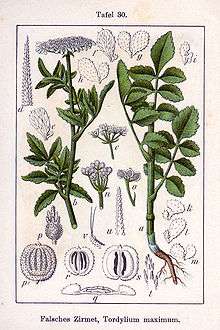Tordylium maximum
| Tordylium maximum | |
|---|---|
 | |
| Scientific classification | |
| Kingdom: | Plantae |
| Clade: | Angiosperms |
| Clade: | Eudicots |
| Clade: | Asterids |
| Order: | Apiales |
| Family: | Apiaceae |
| Genus: | Tordylium |
| Species: | T. maximum |
| Binomial name | |
| Tordylium maximum L.[1] | |
| Synonyms[1] | |
| |
Tordylium maximum, known as hartwort, is an annual or biennial flowering plant in the carrot family (Apiaceae).[2]
Description
Tordylium maximum is a hairy or bristly biennial or annual, growing to about 30–130 cm (1.0–4.3 ft) tall, with a hollow ridged stem that is usually branched. The lower leaves are pinnate, with two to five pairs of coarsely toothed leaflets. The upper leaves may be reduced to a single leaflet. The flowers are arranged in flat umbels, with 5–15 rays. Like other members of the genus Tordylium, the flowers are white, with the outer flowers having some much longer petals on the outer side of the umbel. The fruits are 5–8 mm (0.20–0.31 in) long.[3][2]
Taxonomy
Tordylium maximum was first described by Carl Linnaeus in 1753 in Species Plantarum.[4][5]
Distribution
Tordylium maximum is a species of south and south central Europe, probably not native in the northern parts of its range.[3] It has been found in south-east England, but only in one location in south Essex since 1875.[2]
References
- 1 2 "Tordylium maximum", The Plant List, retrieved 2015-02-27
- 1 2 3 Stace, Clive (2010), New Flora of the British Isles (3rd ed.), Cambridge, UK: Cambridge University Press, ISBN 978-0-521-70772-5, p. 828
- 1 2 Tutin, T.G. (1968), "Tordylium", in Tutin, T.G.; Heywood, V.H.; Burges, N.A.; Valentine, D.H.; Walters, S.M. & Webb, D.A., Flora Europaea, Volume 2: Rosaceae to Umbelliferae, Cambridge University Press, p. 367, ISBN 978-0-521-06662-4
- ↑ "IPNI Plant Name Query Results for Tordylium maximum", The International Plant Names Index, retrieved 2015-02-28
- ↑ Carl Linnaeus (1753), "Tordylium", Species Plantarum, vol. 1, p. 239–240